Chattanooga, Tennessee, Hgh State Clinic, Hgh Injections, Hrt Doctors
Chattanooga, Tennessee Blood Testing Facilities
 Represents a LabCorp blood testing facility
Represents a LabCorp blood testing facility Represents a Quest Diagnostics blood testing facility
Represents a Quest Diagnostics blood testing facility

Nearby Labcorp Blood Testing facilities:
- Labcorp Center Distance: 1 m, 979 East 3Rd Street Ste 127, Chattanooga, Hamilton County, TN, 37404
- Labcorp Center Distance: 6 m, 6016 Shallowford Rd Ste 200, Chattanooga, Hamilton County, TN, 37421
- Labcorp Center Distance: 42 m, 100 Hospital Court, Calhoun, Gordon County, GA, 30701
- Labcorp Center Distance: 54 m, 311 W 8Th St Ne, Rome, Floyd County, GA, 30165
- Labcorp Center Distance: 58 m, 51 Overview Drive, Blue Ridge, Fannin County, GA, 30513
- Labcorp Center Distance: 73 m, 2835 Highway 231 N, Shelbyville, Bedford County, TN, 37160
- Labcorp Center Distance: 74 m, 450 Northside Cherokee Blvd, Canton, Cherokee County, GA, 30115
- Labcorp Center Distance: 75 m, 301 Governors Dr Sw Suite 110, Huntsville, Madison County, AL, 35801
- Labcorp Center Distance: 76 m, 1080 Neal St Ste 201, Cookeville, Putnam County, TN, 38501
- Labcorp Center Distance: 78 m, 1426 Towne Lake Pkwy 103, Woodstock, Cherokee County, GA, 30189
- Labcorp Center Distance: 79 m, 689 Medical Park Dr Ste 202, Lenoir City, Loudon County, TN, 37772
- Labcorp Center Distance: 81 m, 1878 Jeff Rd. Ste F, Huntsville, Madison County, AL, 35806
- Labcorp Center Distance: 85 m, 790 Church St 505, Marietta, Cobb County, GA, 30060
- Labcorp Center Distance: 87 m, 11660 Alpharetta B700 725, Roswell, Fulton County, GA, 30076
- Labcorp Center Distance: 88 m, 110 Main Street, Hiawassee, Towns County, GA, 30546
- Labcorp Center Distance: 89 m, 9625 Kroger Park Dr, Knoxville, Knox County, TN, 37922
- Labcorp Center Distance: 90 m, 320 Branscomb Dr Sw Suite C, Jacksonville, Calhoun County, AL, 36265
- Labcorp Center Distance: 91 m, 158 Hospital Dr, Carthage, Smith County, TN, 37030
- Labcorp Center Distance: 92 m, 690 Dallas Hwy Suite 210, Villa Rica, Carroll County, GA, 30180
- Labcorp Center Distance: 93 m, 4275 Johns Creek Pkwy Ste B, Suwanee, Forsyth County, GA, 30024
- Labcorp Center Distance: 94 m, 755 Mount Vernon Hwy Ne Ste 270, Atlanta, Fulton County, GA, 30328
- Labcorp Center Distance: 95 m, 5667 Peachtree Dunwoody Rd 295, Atlanta, Fulton County, GA, 30342
- Labcorp Center Distance: 96 m, 4206 Sutherland Avenue, Knoxville, Knox County, TN, 37919
- Labcorp Center Distance: 97 m, 3800 Pleasant Hill Rd Ste 1, Duluth, Gwinnett County, GA, 30096
- Labcorp Center Distance: 98 m, 1932 Alcoa Hwy Bldg C155, Knoxville, Knox County, TN, 37920
- Labcorp Center Distance: 99 m, 1412 Leighton Ave, Anniston, Calhoun County, AL, 36207
Nearby Quest Blood Testing facilities:
- Quest Center Distance: 1 m, 600 N Holtzclaw Ave Ste 210, Chattanooga, Hamilton County, TN, 37404-1204
- Quest Center Distance: 75 m, 250 Chateau Drive, Huntsville, Madison County, AL, 35801-3497
- Quest Center Distance: 76 m, 806 Governors Dr Sw, Huntsville, Madison County, AL, 35801-5133
- Quest Center Distance: 82 m, 601 S 4Th St, Gadsden, Etowah County, AL, 35901-5218
- Quest Center Distance: 84 m, 536 N. Thompson Lane Ste F, Murfreesboro, Rutherford County, TN, 37129-4301
- Quest Center Distance: 85 m, 790 Church St Nw, Marietta, Cobb County, GA, 30060-8950
- Quest Center Distance: 89 m, 3055 N Point Pkwy, Alpharetta, Fulton County, GA, 30005-4122
- Quest Center Distance: 91 m, 3825 Medical Park Dr., Austell, Cobb County, GA, 30106-6831
- Quest Center Distance: 95 m, 5673 Peachtree Dunwoody Rd Ne, Atlanta, Fulton County, GA, 30342-1701
- Quest Center Distance: 99 m, 115 Winwood Dr, Lebanon, Wilson County, TN, 37087-3133
Chattanooga Tennessee Hormone Replacement Therapy Services
Your Hormones are part of the framework that sustains human wellness and keeps the body functioning at its physiological peak. Hormone Imbalance can be devastating to a patient's health and lead to a litany of issues which make it difficult or nearly impossible to live your life as you wish. At the Conscious Evolution Institute, we have made it our goal to help patients overcome the pitfalls of Hormone Deficiency so that they can live happier, healthier, and hopefully longer lives. We are a fully certified Hormone Clinic staffed with HRT Professionals that have made it their life's work to get you the care that you deserve as a patient.
We specialize in women and men thirty years of age and older, for the diagnosis and treatment of legitimate Hormone Deficiencies such as Low-T and Hypopituitarism. We have the logistical capability to perform our function remotely using local affiliate physicians in Chattanooga and across the country in order to perform our duties both efficiently and accurately in order to get you affordable and effective Hormone Therapies such as Recombinant HGH and Bio-Identical Testosterone delivered straight to your home so you can get started on the path to wellness as quickly and preparedly as possible.
HGH Injections in Chattanooga Tennessee
Growth Hormone Therapy is one of the most cutting-edge form of wellness therapy that have become prominent in the 21st century. Growth Hormone Deficiency is increasingly recognized as a significant downward pressure on human physical and mental health, and HGH Injections are a highly effective and very safe method of increasing Growth Hormone Levels back to a normal, healthy range, thereby mitigating the effects of HGH Deficiency and enhancing the health of patients suffering from Hypopituitarism. HGH Shots are delivered once-daily via a nearly painless subcutaneous injection. When Growth Hormone Therapy is combined with recommended changes in diet, exercise, and lifestyle, it can lead to astounding changes in a patient's health in a matter of only months.
Injectable Sermorelin in Chattanooga Tennessee
Recombinant Sermorelin Therapy is another option on the table that we proudly offer at the Conscious Evolution Institute. Sermorelin functions on the same premise as Bio-Identical HGH: Improving health by restoring appropriate and healthy Human Growth Hormone Balance. Sermorelin achieves this goal by encouraging the human pituitary to secrete its own natural, endogenous HGH, at levels which correspond to those of a healthy person in young adulthood. If you would like to know more about Sermorelin and whether Prescription Sermorelin is right for you, our Qualified, Licensed Hormone Doctors can fill you in on all the pertinent details.
Testosterone Therapy Clinics in Chattanooga Tennessee
For too long, low libido and sexual dysfunction were simply considered a nasty part of aging. Today, medical professionals and their thankful patients recognize that this is simply not the case. Testosterone Deficiency is one of the leading causes of both ED and low sex drive, and Bio-Identical Testosterone Replacement with Low-T Patches, Topical Gels, and Intramuscular Injections have all been proven to be more than effective at treating the core cause of sexual issues for millions of men across the United States.
If you have been experiencing romantic issues associated with your Testosterone Deficiency, we urge you to reach out to a Certified Hormone Clinic and talk to a Licenced Hormone Specialist, because Low-T is a major risk to not only your love life but your long-term health, wellness, and longevity. Men with Testosterone Deficiency are more likely to die from stroke and heart attack, and they are more likely to suffer from obesity and diabetes than their peers.
Beyond this, Andropause (the male version of menopause), is correlated with increased fragility, low energy levels, anxiety, depression, and more. If you qualify for Physician Mediated Testosterone Therapy, a Testosterone Cream could be all that you need to vastly improve your overall wellbeing.
Chattanooga Tennessee Information
Chattanooga Tennessee is located in the foothills of Lookout Mountain in southeast Tennessee. The city hugs the Tennessee River as it snakes through the lower Cumberland Mountains. The curves of the Tennessee River at this juncture have led this portion of the river to be known as Moccassin Bend. Chattanooga made a name for itself in the 19th and 20th centuries as both an important shipping route and as an ideal location for the manufacture of steel. The city was a highly contested location in the Civil War, and, by far, the most famous battle in the area was at Chickamauga Battlefield, where much of the artillery still sits, preserved, today.
Chattanooga Tourism
The city of Chattanooga has made a name for itself in recent years as being a quality tourist destination, with a number of places to visit such as Ruby Falls, the Chattanooga Choo Choo, Rock City, and the Incline Railway. The Chattanooga Aquarium is also one of the most famous aquariums in the Southeast United States. The city has seen a growing increase in technology and civic development, as the Market Street has undergone a significant revival in the 21st century, and the city was among the first in the entire Southeast to offer Google Fiber, the cutting edge in Internet infrastructure in America today.
Chattanooga Education
Chattanooga is home to the University of Chattanooga, the 2nd most-attended university in the state of Tennessee. They are known as the Mocs, and were originally named after the Moccasins famously worn by Native Americans. In recent years, the University decided to change the meaning of the name to be a truncation of the Mockingbird, which is the state bird of the state of Tennessee.
Chattanooga Neighborhoods and Suburbs
Suburbs of Chattanooga include Fort Oglethorpe Georgia, Soddy-Daisy, East Ridge, Jasper, Red Bank, Ooltewah, Lookout Mountain, and Collegedale. Among the neighborhoods in Chattanooga are UTC, Tiftonia, Riverview, Orchard Knob, Oak Grove, Northshore, Manchester Park, Highland Park, Brainerd, Clifton Hills, Avondale, and Alton Park.
All About Chattanooga, Tennessee Geographic Area
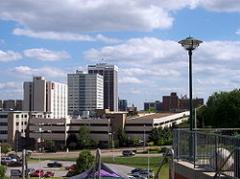

Chattanooga is the fourth-largest city in the U.S. state of Tennessee, with a population of 167,674 as of the 2010 census. It is the seat of Hamilton County. Located in southeastern Tennessee on Chickamauga Lake and Nickajack Lake, which are both part of the Tennessee River, Chattanooga lies approximately 120 miles (190 km) to the northwest of Atlanta, Georgia, 120 miles (190 km) to the southwest of Knoxville, about 135 miles (217 km) to the southeast of Nashville, about 120 miles (190 km) to the northeast of Huntsville, Alabama, and about 148 miles (238 km) to the northeast of Birmingham, Alabama. Chattanooga abuts the Georgia border and is where three major interstate highways meet: I-24, I-75, and I-59.
The city, which has a downtown elevation of approximately 680 feet (210 m), lies at the transition between the ridge-and-valley portion of the Appalachian Mountains and the Cumberland Plateau. The city is therefore surrounded by various mountains and ridges. The official nickname for Chattanooga is the "Scenic City." Several unofficial nicknames include "River City", "Nooga", "Chattown", and "Gig City", demonstrating that Chattanooga currently has the fastest internet service in the Western Hemisphere.
Chattanooga is internationally known for the 1941 gold record song "Chattanooga Choo Choo", which was composed by Glenn Miller and his orchestra.
Since 1990, Chattanooga has been recognized as a Tree City USA community.
The first inhabitants of the Chattanooga area were American Indians. Sites dating back to the Upper Paleolithic period showed continuous occupation through the Archaic, Woodland, Mississippian/Muskogean (900 ae1650), and Cherokee (1776 ae1838) periods.
The first part of "Chattanooga" derives from the Muskogean word cvto /chatR³/ ae 'rock'. The latter may be derived from a regional suffix -nunga meaning dwelling or dwelling place.
A late 19th century history recounted:
The earliest Cherokee occupation dates from Dragging Canoe, who in 1776 separated himself and moved downriver from the main tribe to establish American Indian resistance (see Chickamauga Wars) to European settlement in the southeastern United States. In 1816 John Ross, who later became Principal Chief, established Ross's Landing. Located along what is now Broad Street, it became one of the centers of Cherokee Nation settlement, which also extended into Georgia and Alabama.
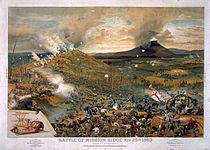
In 1838 the US government forced the Cherokees, along with other American Indians from southeastern U.S. states, to relocate in what is the state of Oklahoma. Their journey west became known as the "Trail of Tears" for their exile and fatalities along the way. The US Army used Ross's Landing as the site of one of three large internment camps, or "emigration depots", where American Indians were held prior to the journey on the Trail of Tears. One of the internment camps was located in Fort Payne, Alabama and the largest was at Fort Cass, Tennessee.
In 1838, the community of Ross's Landing incorporated as the city of Chattanooga. The city grew quickly, initially benefiting from a location well-suited for river commerce. With the arrival of the railroad in 1850, Chattanooga became a boom town. The city was known as the site "where cotton meets corn," referring to its location along the cultural boundary between the mountain communities of Southern Appalachia to the north and the cotton-growing states to the south.
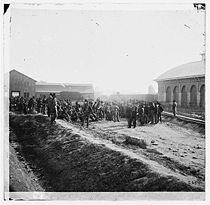
During the American Civil War, Chattanooga was a center of battle. During the Chickamauga Campaign, Union artillery bombarded Chattanooga as a diversion and occupied it on September 9, 1863. Following the Battle of Chickamauga, the defeated Union Army retreated to safety in Chattanooga. On November 23, 1863, the Battles for Chattanooga began when Union forces led by future United States President and Maj. Gen. Ulysses S. Grant reinforced troops at Chattanooga and advanced to Orchard Knob against Confederate troops besieging the city. The next day, the Battle of Lookout Mountain was fought, driving the Confederates off the mountain. On November 25, Grant's army routed the Confederates in the Battle of Missionary Ridge. These battles were followed the next spring by the Atlanta Campaign, beginning just over the nearby state line in Georgia and moving southeastward. After the war ended, the city became a major railroad hub and industrial and manufacturing center.
The largest flood in Chattanooga aos history occurred in 1867, before the Tennessee Valley Authority (TVA) system was created in 1933 by Congress. The flood crested at 58 feet and completely inundated the city. Since the completion of the reservoir system, the highest Chattanooga flood stage has been nearly 37 feet, which occurred in 1973. Without regulation, the flood would have crested at 52.4 feet. Chattanooga was a major priority in the design of the TVA reservoir system and remains a major operating priority in the 21st century.
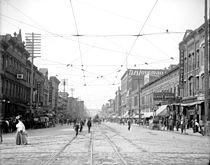
In December 1906, Chattanooga was in the national headlines as the United States Supreme Court, in its only criminal case in its history, ruled that Hamilton County Sheriff Joseph H. Shipp had violated Ed Johnson's civil rights when Shipp allowed a mob to enter the Hamilton County Jail and lynch Johnson on the Walnut Street Bridge in United States v. Shipp. Chattanooga grew with the entry of the United States in the First World War in 1917, as the nearest training camp was in Fort Oglethorpe, Georgia. Chattanooga suffered the effects of the Influenza of 1918 from before the end of the First World War in November 1918 to February 1919 by having movie theaters and pool halls closed, among other effects. By the 1930s Chattanooga was known as the "Dynamo of Dixie", inspiring the 1941 Glenn Miller big-band swing song "Chattanooga Choo Choo".
The same mountains that provided Chattanooga's scenic backdrop also served to trap industrial pollutants which caused them to settle over the community, so much that in 1969, the federal government declared that Chattanooga had the dirtiest air in the nation. But environmental crises were not the only problems plaguing the city. Like other early industrial cities, Chattanooga entered the 1980s with serious socioeconomic challenges, including job layoffs due to de-industrialization, a deteriorating city infrastructure, racial tensions, and social division. Because of these factors, Chattanooga's population declined by more than 10% in the 1980s. However, Chattanooga was the only major U.S. city to lose this proportion of its population in the 1980s and then regain the same proportion in the next two decades.
In recent years, substantial private and governmental resources have been invested in transforming the city's tarnished image. They have worked to revitalize its downtown and riverfront areas, making use of its natural resources. An early cornerstone of this project was the restoration of the historic Walnut Street Bridge. The Walnut Street Bridge is the oldest surviving bridge of its kind in the Southeastern United States.
Efforts to improve the city include the "21st Century Waterfront Plan" ae a $120 million redevelopment of the Chattanooga waterfront and downtown area, which was completed in 2005. The Tennessee Aquarium, which opened in 1992, has become a major waterfront attraction that has helped to spur neighborhood development. Chattanooga has garnered numerous accolades for its transformation of its image. The city has won three national awards for outstanding "livability", and nine Gunther Blue Ribbon Awards for excellence in housing and consolidated planning. In addition to winning various national and regional awards, Chattanooga was the profile city of the August 2007 edition of US Airways Magazine, Volkswagen announced the construction of its first U.S. auto plant in over three decades, the Volkswagen Chattanooga Assembly Plant, in July 2008, Chattanooga was ranked 8th out of America's 100 largest metro areas for the best "Bang For Your Buck" city, according to Forbes magazine, which measured overall affordability, housing rates, and more, in December 2009, and got the first one gigabit a second Internet service in the United States in September 2010 through the city-owned utility of EPB, among other major events.
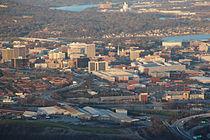
Chattanooga's economy includes a diversified and growing mix of manufacturing and service industries.
Notable Chattanooga businesses include Access America Transport, The insurance powerhouse Reliance Partners, Astec Industries, BlueCross BlueShield of Tennessee, CBL & Associates, The Chattanooga Bakery, Chattem, the world's first Coca-Cola bottling plant, Coker Tire, Covenant Transport, Double Cola, FSGBank, CraftWorks Restaurants & Breweries, Heatec, Krystal, Litespeed, Luken Communications, Miller & Martin, the National Model Railroad Association, Olan Mills, Inc., Republic Parking System, Roadtec, Rock/Creek, Southtree, Tricycle Inc., Unum, and U.S. Xpress Enterprises Inc. The city also hosts large branch offices of Cigna, AT&T, T-Mobile USA, and UBS. McKee Foods Corporation, maker of Little Debbie brand snack cakes, is a privately held, family-run company headquartered in nearby Collegedale, Tennessee.
Notable companies that have manufacturing or distribution facilities in the city include Alstom, Amazon.com, BASF, DuPont, Invista, Komatsu, Rock-Tenn, Plantronics, Domtar, Norfolk Southern, Alco Chemical, Colonial Pipeline, and Buzzi Unicem. The William Wrigley Jr. Company has a prominent presence in Chattanooga, the sole site of production of Altoids breath mint products since 2005. There is also a Vulcan Materials quarry in the vicinity of the city.
In May 2011, Volkswagen Group of America inaugurated its Chattanooga Assembly Plant. The $1 billion plant, opened in May 2011, serves as the group's North American manufacturing headquarters. The plant is the first one in the United States for Volkswagen since the 1988 closure of the Volkswagen Westmoreland Assembly Plant near New Stanton, Pennsylvania.
In addition to corporate business interests, there are many retail shops in Chattanooga, including three shopping malls: Hamilton Place Mall in East Brainerd, Northgate Mall in Hixson, and Eastgate Mall in Brainerd. The P.F. Chang's restaurant at Hamilton Place Mall has had a unique theme since the restaurant opened in November 2006: a water theme, based on the fundamental role the Tennessee River plays in Chattanooga and the fact that the CEO of P.F. Chang's since 2000, Richard Federico, is a 1976 alumnus of the University of Tennessee and has family in Chattanooga. In December 2001, Chattanooga was the site of the first two Dairy Queen Grill and Chill restaurants in the United States.
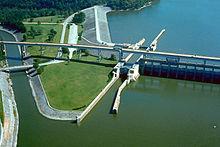
Electric power for most of the city and surrounding area is provided by the city-run Electric Power Board (EPB). EPB also provides high-speed Internet service, TV, and telephone service to business and residential customers throughout Hamilton County, as well as parts of Bledsoe County, Bradley County, Catoosa County, Dade County, Marion County, Rhea County, Sequatchie County, and Walker County, via the nation's largest municipally owned fiber optic system. TVA operates the nearby Sequoyah Nuclear Power Plant, Chickamauga Dam, and the Raccoon Mountain Pumped-Storage Plant, all of which provide electricity to the greater Chattanooga area. TVA's corporate power generation and distribution organization is headquartered in downtown Chattanooga.
Natural gas and water are provided by the privately run Chattanooga Gas Company and Tennessee-American Water Company, respectively. In 2005, Mayor Ron Littlefield stated his desire for the city to purchase the Tennessee-American Water Company, which was sold in a public offering in 2007. Former Mayor Jon Kinsey's attempts to have the city buy control of Tennessee-American Water were defeated in court.
Comcast remains the dominant cable provider for most areas of the city. The incumbent telephone company is AT&T Inc. However, competing phone companies, such as EPB, cellular phones, and VoIP are making inroads. A major interstate fiber optics line operated by AT&T traverses the city, making its way from Atlanta to Cincinnati. There are more choices between TV, Internet, and phone service providers for Chattanooga residents than in most other cities its size because of the intense competition between AT&T, Comcast, and EPB.
Beginning in 2009 and continuing through March 2011, when Haletown, Tennessee received service from EPB's fiber optic network, EPB began to establish its exclusive fiber optic network to its 600 square miles service area, which covers the greater Chattanooga Metropolitan Statistical Area. In September 2010, EPB became the first municipally-owned utilities company to offer internet access directly to the public at speeds up to one gigabit per second in the United States utilizing its exclusive fiber optics network. The fiber optic network has been emulated by at least six other cities in Tennessee and studied by other cities in the US and even internationally. Jay Weatherill, South Australia's Premier, visited Chattanooga in January 2012 and "looked at the current gigabit network that was supporting critical city safety functions such as police and fire communications infrastructure, equipment and applications. He also inspected wastewater management, storm water management, traffic control and medical diagnostics applications [and] first-hand operations of a smart lighting and camera system that allows the police to control public lighting and see what is happening in heavy crime areas. [The article says the] use of broadband to carry the video and control signaling has contributed to making Chattanooga aos Coolidge Park a safer place to visit."
In 2011 the expansion of EPB's network became a subject of major controversy in Tennessee. The success of its network, credited with the expansion of Volkswagen's Chattanooga plant and the establishment of Amazon.com facilities in Chattanooga and Cleveland, led to a number of legal challenges by AT&T and Comcast insisting that public funds not be used to fund expansion of public networks in competition with private ones. However, according to EPB itself, federal agencies, electricity industry trade sources, and other press sources, the investment in the fully fiber optic network is justified by electrical system benefits alone, including early fault detection and decreases in standby power.
The current mayor is Ron Littlefield, a long-time city councilman, who was elected in a run-off election in April 2005. Mayor Littlefield was reelected to a second four year term in March 2009.
The city operates under a charter granted by the state legislature in 1852; the charter has been subsequently amended. The city operates under a strong mayor system, which changed from a white-dominated commission form of government when U.S. District Judge R. Allan Edgar ruled in 1989 that the commission-style government violated the Voting Rights Act of 1965 by diluting the black vote. As a result of Brown v. Board of Commissioners, Chattanooga abandoned the at-large voting system that it had used for the commission form of government, established districts that represented minorities, eliminated voting privileges for non-resident property owners, and created the city's current mayor-council form of government. The current strong mayor system started in 1991 after a 1990 city-wide election that used the district system.
The city's legislative branch is split up into nine districts, with a council member for each district selected in partisan elections. The current council members are Deborah Scott (District 1), Sally Robinson (District 2), Pam Ladd (District 3), Jack Benson (District 4), Russell Gilbert (District 5), Carol Berz (District 6), Manuel "Manny" Rico (District 7), Andrae McGary (District 8), and Peter Murphy (District 9).
Chattanooga's delegation to the Tennessee House of Representatives includes Gerald McCormick (R), who represents District 26, Richard Floyd (R), who represents District 27, Tommie Brown (D), who represents District 28, JoAnne Favors (D), who represents District 29, Vince Dean (R), who represents District 30, and Jim Cobb (R), who represents District 31. In the Tennessee Senate, Chattanooga is divided between Districts 10 and 11, who are represented by Andy Berke (D) and Bo Watson (R), respectively.
Chattanooga is represented in the United States House of Representatives by Chuck Fleischmann (R), who represents the 3rd District. In the United States Senate, both Bob Corker (R) and Lamar Alexander (R) have district offices in Chattanooga.
Chattanooga, as the county seat of Hamilton County, is home to Chattanooga's City Courts and Hamilton County's Courts.
Chattanooga is the location of the United States District Court for the Eastern District of Tennessee's Southern Division, which sits in the Joel W. Solomon Federal Courthouse. The Southern Division has jurisdiction over Bledsoe, Bradley, Hamilton, Marion, McMinn, Meigs, Polk, Rhea, and Sequatchie counties.
Chattanooga is protected by the Chattanooga Police Department, which dates from 1852 and made Chattanooga one of the first major Southern cities to have black police officers, starting in 1883. However, the police officers were subsequently removed from the force and were reintroduced on a permanent basis on August 11, 1948, still years before other major cities in the Southeast, such as Birmingham, Alabama and Jackson, Mississippi, integrated their police departments. The seven officers, including Officers Thaddeus Arnold, Singer Askins, W.B. Baulridge, C.E. Black, Morris Glenn, Arthur Heard, and Thomas Patterson, were initially restricted to walking beats in black neighborhoods. In 1960, black police officers were authorized to patrol all neighborhoods and arrest white citizens.
Most of Chattanooga's primary and secondary education is funded by the government. The public schools in Chattanooga, as well as Hamilton County, have fallen under the purview of the Hamilton County School System since the 1997 merger of the urban Chattanooga City Schools system and the rural Hamilton County Schools system. The Howard School, now a magnet school, was the first public school in the area, established in 1865 after the Civil War. The Chattanooga School for the Arts and Sciences and the Chattanooga High School Center for Creative Arts are additional public magnet schools.
In addition, the city is home to several private and parochial secondary schools, including Baylor School, Boyd-Buchanan School, McCallie School, Girls Preparatory School, Chattanooga Christian School, and Notre Dame High School. The Siskin Children's Institute in Chattanooga is a specialized institution in the field of early childhood special education.
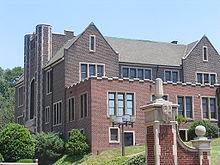
In addition to the various elementary, middle, and secondary schools that Chattanooga has, a wide variety of higher education institutions can be found in the city and nearby. The University of Tennessee at Chattanooga is the second largest campus of the University of Tennessee System, with a student population of over 10,000. Chattanooga State Community College is a two-year community college with a total undergraduate enrollment of roughly 11,000 students. Tennessee Temple University is a Baptist college located in the Highland Park neighborhood. Chattanooga is also home to a branch of the University of Tennessee College of Medicine, which provides medical education to third and fourth year medical students, residents, and other medical professionals in southeast Tennessee through an affiliation with Erlanger Health System. Covenant College, a private liberal arts college operated by the Presbyterian Church in America, is located in the nearby suburb of Lookout Mountain, Georgia and has a student population of about 1,000. Southern Adventist University is located in the suburb of Collegedale, Tennessee and enrolls roughly 3,000 students. Virginia College School of Business and Health offers a variety of programs leading to diplomas, associate degrees, and bachelor degrees. Virginia College provides programs such as office or business management, health/medical, and criminal justice.
The Chattanooga-Hamilton County Bicentennial Library system had been jointly operated by the city and county governments since 1976; due to Chattanooga terminating a 1966 agreement with Hamilton County to distribute sales tax revenue equally, the city has taken over full funding responsibilities as of 2011. The city was gifted with a Carnegie library in 1904, and the two-story purpose-built marble structure survives to this day at Eighth Street and Georgia Avenue as commercial office space. In 1939, the library moved to Douglas Street and McCallie Avenue and shared the new building with the John Storrs Fletcher Library of the University of Chattanooga. This building is now called Fletcher Hall and houses classrooms and offices for the University. In 1976, the city library moved to its third and current location at the corner of Tenth and Broad streets.
Chattanooga has three hospital systems: Erlanger Hospital System, Parkridge Hospital System, and Memorial Hospital System.
Erlanger Hospital is a non-profit academic teaching center affiliated with the University of Tennessee's College of Medicine. Erlanger is also the area's primary trauma center, a Level-One Trauma Center for adults, and the only provider of tertiary care for the residents of southeastern Tennessee, north Georgia, northeastern Alabama, and western North Carolina. Erlanger treats approximately 250,000 people every year. In 2008, Erlanger was named one of the nation's "100 Top teaching hospitals for cardiovascular care" by Thomson Reuters. Erlanger has been operated by the Chattanooga-Hamilton County Hospital Authority since 1976.
Parkridge Hospital is located east of downtown in the Glenwood district and is run by Tri-Star Healthcare. Tri-Star also operates Parkridge East Medical Center in nearby East Ridge.
Memorial Hospital, which is operated by Denver-based Catholic Health Initiatives, is located downtown. In 2004, Memorial was named one of the "100 Top Teaching Hospitals" by Thomson Reuters.
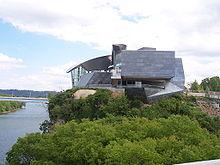
As the birthplace of the tow truck, Chattanooga is the home of the International Towing and Recovery Hall of Fame and Museum. Another transportation icon, the passenger train, can be found at the Tennessee Valley Railroad Museum, or called TVRM by locals, which is the largest operating historic railroad in the South. Chattanooga is home to the Hunter Museum of American Art. Other notable museums include the Chattanooga Regional History Museum, the National Medal of Honor Museum, the Houston Museum, the Chattanooga African American Museum, and the Creative Discovery Museum.
Chattanooga has a wide range of performing arts in different venues. Chattanooga's historic Tivoli Theatre, dating from 1921, is home to the Chattanooga Symphony and Opera (CSO), which became the first merged symphony opera and opera company in the United States in 1985. The CSO performs under the baton of Kayoko Dan. The Chattanooga Theatre Centre offers 15 productions each year in three separate theater programs: the Mainstage, the Circle Theater, and the Youth Theater. Another popular performance venue is Memorial Auditorium.
Chattanooga hosts several writing conferences, including the Conference on Southern Literature and the Festival of Writers, both sponsored by the Arts & Education Council of Chattanooga.
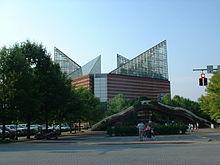
Chattanooga touts many attractions, including the Tennessee Aquarium, caverns, and new waterfront attractions along and across the Tennessee River. In the downtown area is the Chattanooga Choo Choo Hotel, housed in the renovated Terminal Station and exhibiting the largest HO model train layout in the United States. Also downtown are the Creative Discovery Museum, a hands-on children's museum dedicated to science, art, and music; an IMAX 3D Theatre, and the newly expanded Hunter Museum of American Art. The Tennessee Riverwalk, an approximately 13-mile (21 km) long trail running alongside the river, is another attraction for both tourists and residents alike.
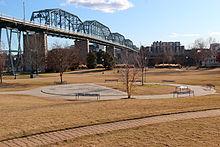
Across the river from downtown is the North Shore district, roughly bounded by the Olgiati Bridge to the west and Veterans Bridge to the east. The newly renovated area draws locals and tourists to locally owned independent boutique stores and restaurants, plus attractions along the Chattanooga Riverpark system, including Coolidge Park and Renaissance Park. Chattanooga's only floating hotel, the Delta Queen, is a unique attraction alongside the North Shore and is permanently docked at Coolidge Park.
The Chattanooga Zoo at Warner Park is located a short distance from the downtown area.
Parks and natural scenic areas provide other attractions. The red-and-black painted "See Rock City" barns along highways in the Southeast are remnants of a now-classic Americana tourism campaign to attract visitors to the Rock City tourist attraction in nearby Lookout Mountain, Georgia. The mountain is also the site of Ruby Falls and Craven's House. The Lookout Mountain Incline Railway is a steep funicular railway that rises from the St. Elmo Historic District to the top of the mountain, where passengers can visit the National Park Service's Point Park and the Battles for Chattanooga Museum. Formerly known as Confederama, the museum includes a diorama that details the Battle of Chattanooga. From the military park, visitors can enjoy the panoramic views of Moccasin Bend and the Chattanooga skyline from the mountain's famous "point" or from vantage points along the well-marked trail system.
Near Chattanooga, the Raccoon Mountain Reservoir, Raccoon Mountain Caverns, and Reflection Riding Arboretum and Botanical Garden boast a number of outdoor and family fun opportunities. Other arboretums include Bonny Oaks Arboretum, Cherokee Arboretum at Audubon Acres, and Cherokee Trail Arboretum. The Ocoee River, host to a number of events at the 1996 Atlanta Olympics, features rafting, kayaking, camping, and hiking. Just outside Chattanooga is the Lake Winnepesaukah amusement park. The Cumberland Trail begins in Signal Mountain, just outside of Chattanooga.
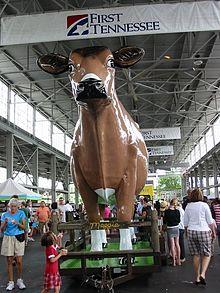
Chattanooga hosts the well-known Riverbend Festival, an annual nine-day music festival held in June in the downtown area. One of the most popular events is the "Bessie Smith Strut", a one-night showcase of blues and jazz music named for the city's most noted blues singer. The annual "Southern Brewer's Festival" and the "River Roast" festival celebrate such traditional Southern staples as beer and barbecue.
New events, such as GoFest!, "Between the Bridges" wakeboard competition, and Talespin, complement well-established events, such as Riverbend and the Southern Brewer's Festival, and attract their own audiences.[100][101] Back Row Films is a city-wide celebration of film co-sponsored by the Hunter Museum of American Art, the Arts & Education Council and UTC.[102]
"Nightfall" is a free weekly concert series in Miller Plaza on Friday nights that features an eclectic mix of rock, blues, jazz, reggae, zydeco, funk, bluegrass, and folk music from Memorial Day until the end of September.[103] The Chattanooga Market features events all year round as part of the "Sunday at the Southside", including an Oktoberfest in mid-October.
The Chattanooga Dulcimer Festival, held each June, features workshops for mountain dulcimer, hammered dulcimer, and auto harp, among others, along with performances by champion performers from across the nation.[104] Chattanooga is also the center of much bluegrass music. In 1935, as well as from 1993 to 1995, the city hosted the National Folk Festival.
Each January, Chattanooga plays host to Chattacon, a science fiction and fantasy literary convention.[105] The convention is organized by the nonprofit Chattanooga Speculative Fiction Fans, Inc. First held in 1976, the convention drew more than 1,000 attendees to the Chattanooga Choo Choo Hotel in 2011, as well as an estimated 1,000 attendees in 2012.[106][107]
Chattanooga has a large and diversified sports scene for a city of its size, including college sports, minor league baseball, semi-professional teams, and a large nationally-renowned regatta the first weekend in November.
Chattanooga was the home of the NCAA Division I Football Championship game, which had been held at Finley Stadium in Chattanooga, from 1997 to 2009. From 2010 to 2012, the Dallas, Texas suburb of Frisco will host the NCAA Division I Football Championship game.
The University of Tennessee at Chattanooga (UTC) Mocs compete in NCAA Division I and the Southern Conference. UTC's athletic programs include football at the FCS level, women's soccer, volleyball, and cross country in the fall; men's and women's basketball, wrestling, and indoor track & field in the winter; and softball and outdoor track & field in the spring. Men's and women's golf and men's and women's tennis play in the fall and spring.
The Chattanooga Lookouts, a Class AA Southern League baseball team affiliated with the Los Angeles Dodgers, boast a loyal following and respectable participation in season-end playoffs.[108] Games take center stage at the downtown riverfront AT&T Field with tickets starting at only $5.
Chattanooga is also home to several semi-professional sports teams, including Chattanooga FC, the Tennessee Crush, and the Chattanooga Steam. The two teams that play at Finley Stadium are Chattanooga FC, a soccer team that currently plays in the National Premier Soccer League, and the Tennessee Crush, a football team. The Chattanooga Steam plays at Lookout Valley High School near Lookout Mountain.
Chattanooga is home to the Chattanooga Rugby Football Club, which was established in 1978. The club, the 2011 Mid South champions, is affiliated with USA Rugby and USA Rugby South, which encompasses the D2 Mid South Division.[109] There is also a Women's Rugby Team, as well as collegiate Men's and Women's teams at the University of Tennessee at Chattanooga. All four teams play their home matches at Montague Park.

The Tennessee River, which flows through the middle of Chattanooga, is an excellent place to row. The well-known Head of the Hooch rowing regatta takes place in downtown Chattanooga during the first weekend of November. The head race originally took place on the Chattahoochee River in Atlanta before moving to Chattanooga in 2005, hence the name Head of the Hooch. With 1,922 boats in 2010 and 1,965 boats in 2011, this competition ranks as the 2nd largest regatta in the United States, with numerous college and youth teams, such as UNC Men's Crew, Vanderbilt Rowing Club, James Madison University Crew, University of Tennessee Women's Rowing, Orlando Rowing Club, Nashville Rowing Club, Newport Rowing Club, and Chattanooga Rowing, competing.[110][111][112] There are also multiple rowing clubs such as the Lookout Rowing Club for adults and Chattanooga Junior Rowing Club for high school students. The weekend of the Head of the Hooch also sees hot-air balloon rides and other activities.
Due to its location at the junction of the Cumberland Plateau and the southern Appalachians, Chattanooga has become a haven for outdoor sports such as hunting, fishing, trail running, road running, adventure racing, rock climbing, mountain biking, and road biking. The city boasts a number of outdoor clubs: Scenic City Velo, SORBA-Chattanooga, the Wilderness Trail Running Association, and the Chattanooga Track Club. The city also funds Outdoor Chattanooga, an organization focused on promoting outdoor recreation. In September 2004, the city appointed its first-ever executive director of Outdoor Chattanooga to implement the organization's mission, which includes promoting bicycling for transportation, recreation, and active living.[113] For paddlers, Chattanooga offers the Tennessee River Blueway, a 50-mile (80 km) recreational section of the Tennessee River that flows through Chattanooga and the Tennessee River Gorge. The Tennessee Aquarium has a high speed catamaran, the River Gorge Explorer, to allow up to 70 people to explore the Tennessee River Gorge.[114] The Explorer departs from the Chattanooga Pier.[115]
As of the census of 2010, there were 167,674 people, 70,749 households, and 40,384 families residing in the city. The population density was 1,222.5 people per square mile (472.5/km ²). There were 79,607 housing units at an average density of 588.8 per square mile (226.0/km ²). The racial makeup of the city was 58% White, 34.9% Black, 0.4% American Indian, 2% Asian, 0.1% Pacific Islander, 1.9% from other races, and 1.3% from two or more races. 5.5% of the population were Hispanic or Latino of any race. Non-Hispanic Whites were 55.9% of the population in 2010, down from 67.3% in 1980.[116] [117] There were 70,749 households out of which 26.7% had children under the age of 18 living with them, 36% were married couples living together, 17.3% had a female householder with no husband present, and 42% were non-families. 33.5% of all households were made up of individuals and 26% had someone living alone who was 65 years of age or older. The average household size was 2.26 and the average family size was 2.94. Same-sex couple households comprised 2.6% of all households.[118]
In the city the population was spread out with 21.3% under the age of 18, 11.5% from 18 to 24, 27% from 25 to 44, 25.5% from 45 to 64, and 14.7% who were 65 years of age or older. The median age was 38.1 years. 46.1% of the population was male and 53.9% of the population was female.
The median income for a household in the city was $35,817, and the median income for a family was $43,314. Males had a median income of $36,109 versus $31,077 for females. The per capita income for the city was $23,756. About 14% of families and 16.5% of the population were below the poverty line, including 27% of those under age 18 and 13.8% of those age 65 or over.
Chattanooga's Metropolitan Statistical Area, which includes Hamilton, Marion, and Sequatchie counties in Tennessee and Catoosa, Dade, and Walker counties in Georgia, grew from 476,531 people, as of the 2000 census, to 529,222 people, as of the 2010 census, a 9% increase during the 2000s (decade).[119]
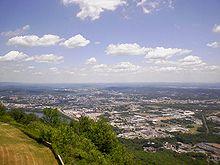
The city is located at latitude 35 °4' North, longitude 85 °15' West.
According to the United States Census Bureau, the city has a total area of 143.2 square miles (371 km2), of which 135.2 square miles (350 km2) is land and 8.0 square miles (21 km2) (5.56%) is water. In terms of land area, Chattanooga ranks 68th, which is between Las Vegas, Nevada and Philadelphia. The total area of Chattanooga makes the city larger than that of many cities larger in population, such as Baltimore, Maryland, Atlanta, Fort Wayne, Indiana, Salt Lake City, and Palm Springs, California.
The most prominent natural features in and around Chattanooga are the Tennessee River and the surrounding mountains. The city is nestled between the southwestern Ridge-and-valley Appalachians and the foot of Walden's Ridge; the river separates the ridge from the western side of downtown. Several miles east, the city is bisected by Missionary Ridge, site of an important battle in the Civil War.
The Tennessee River is impounded by the TVA's Chickamauga Dam north of the downtown area. Five automobile bridges, one railroad trestle, and one pedestrian bridge, all described below, cross the river.
Road transport is facilitated by Interstate 75 to Atlanta and Knoxville, Interstate 24 to Nashville, and Interstate 59 to Birmingham. Chattanooga and portions of Southeast Tennessee and North Georgia is served by the Chattanooga Metropolitan Airport. CSX transports rail freight to Atlanta and Nashville, and Norfolk Southern conveys rail cargo to Atlanta, Birmingham, Cincinnati, Knoxville, and Memphis.
In addition to the restoration of downtown, many of Chattanooga's neighborhoods have experienced a rebirth of their own. Chattanooga has many buildings on the National Register of Historic Places and three neighborhoods: Ferger Place, Fort Wood, and St. Elmo. Additionally, Chattanooga has ten local historic districts: Fort Wood, Ferger Place, Glenwood, Missionary Ridge, Market and Main Streets, Market Street Warehouse, M.L. King Boulevard, St. Elmo, Stone Fort Land Company, and Stringer Ridge. The neighborhood of Highland Park is being considered for designation.[120]
Chattanooga, as with much of Tennessee, has a four-season humid subtropical climate (Koppen Cfa). Winter days are usually mild but there are several days per year where conditions stay at or below freezing temperatures all day.[121] Snow is not common; the 1971 ae2000 snowfall seasonal median was 0.6 inches (1.5 cm). However, in the winter of 2011, 11 inches was recorded between January 9 ae10, 2011.[121] Summers are hot and humid, with a July daily mean of 79.6 °F (26.4 °C) and 46 days annually with 90 °F (32 °C) or greater temperatures.[121]
Considered to be the gateway to the Deep South, the Midwest, and the Northeast, Chattanooga's extensive transportation infrastructure has developed into an intricate system of interstates, streets, tunnels, the Chattanooga Area Regional Transportation Authority (CARTA), railroad lines, bridges, the Tennessee River, and the Chattanooga Metropolitan Airport. The main hubs of Chattanooga's transportation infrastructure include Interstates 24, 59, and 75.
See also List of Tennessee state highways
The city is served by a publicly run bus company, the Chattanooga Area Regional Transportation Authority (CARTA). CARTA operates 17 routes, including a free electric shuttle service in the downtown area, and free wireless Internet on certain "smartbuses".[124]
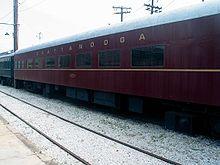
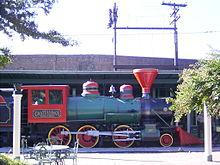
Despite a new emphasis on the technology and service sectors, Chattanooga maintains strong ties to the past and serves as a major freight hub with Norfolk Southern (NS) and CSX running trains on their own (and each other's) lines. The Norfolk Southern Railway's enormous classification yard DeButts Yard is just east of downtown; Norfolk Southern's Shipp's Yard and CSX's Wauhatchie Yard are southwest of the city. Norfolk Southern maintains a large railroad repair shop in Chattanooga.[125] The two railroad companies are among the largest individual landowners in the city (the Federal Government is another). The Tennessee Valley Railroad Museum (TVRM), the largest historic operating railroad in the South, and the Chattooga and Chickamauga Railway also provides railroad service in Chattanooga. The headquarters of the National Model Railroad Association (NMRA) has been in Chattanooga next to the TVRM since 1982, when the NMRA moved from Indianapolis, Indiana.[126]
Since both NS and CSX both run through Chattanooga, here are the lines that run through the town (the AAR reporting marks are used for the following railroads: NS for Norfolk Southern, CSXT for CSX Transportation, TVRM for the Tennessee Valley Railroad Museum (TNT for subsidiary Tyner Terminal Railroad), and CCKY for Chattooga and Chickamauga Railway):
Also, the Lookout Mountain Incline Railway, often referred to as the Incline Railway by locals, as well as being a tourist attraction, is sometimes used for commuting by Lookout Mountain residents, particularly during wintry weather, when traveling up and down the mountain could be very dangerous.
As mentioned above, Chattanooga's most famous connection to the railroad industry is Chattanooga Choo Choo, a song made famous by Glenn Miller & His Orchestra.
Despite the high level of freight rail activity, there is no passenger rail service in the city for either commuters or long-distance travelers.
Being bisected by a major waterway, Chattanooga has several large bridges that allow people to traverse the Tennessee River. These are the following, from west to east:
The Chattanooga Metropolitan Airport offers non-stop service to various domestic destinations via regional and national airlines, including Allegiant Airlines, American Eagle, Delta Connection, and US Airways Express.[129]
The city of Chattanooga is served by numerous local, regional, and national media outlets which reach approximately one million people in four states: Tennessee, Georgia, Alabama, and North Carolina.
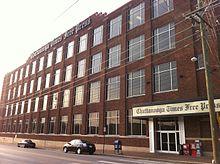
The Chattanooga Times Free Press, the area's only daily newspaper, is published every morning. It was formed in 1999 from the merger of two papers that had been bitter rivals for half a century, the Times and the News-Free Press. The Times was owned and published by Adolph Ochs, who later bought the New York Times. The Times was the morning paper and had a generally more liberal editorial page. The News-Free Press, whose name was the result of an earlier merger, was an afternoon daily and its editorials were more conservative than those in the Times. On August 27, 1966, the News-Free Press became the first newspaper in the nation to dissolve a joint operating agreement.[130][131] In 1999, the Free Press, which had changed its name from News-Free Press in 1993, was bought by an Arkansas company, WEHCO Media, publisher of the Arkansas Democrat-Gazette, which then bought The Times from the Ochs heirs.[132] The Times Free Press is the only newspaper in the United States to have 2 editorial pages, each reflecting opposite ends of the political spectrum. The Times' editorial page, which is liberal, is on the left page and the Free Press' editorial page, which is conservative, is on the right page.[133]
"Enigma" is a free weekly pop culture and entertainment newspaper published every Wednesday. Founded in 1995 by David Weinthal, Enigma is Chattanooga's oldest and longest running alternative newspaper. The newspaper covers the greater Chattanooga area as well as different events across the Southeast, including everything from major concerts and festivals to college and professional sports.
The "Chattanooga Pulse" is a weekly alternative newspaper, published every Wednesday. It was formed in 2003 by Zachary Cooper and Michael Kull, running independently until 2008, when the paper was purchased by local broadcast radio and website development firm Brewer Media Group. The newspaper shared news gathering resources with Brewer Media Group's News Talk 95.3 WPLZ radio station until January 2012 when the news talk radio format was changed to country.[134]
The Chattanoogan and its website "Chattanoogan.com", established in 1999, is an online media outlet that concentrates on news from Chattanooga. The publisher is John Wilson, previously a staff writer for the Chattanooga Free Press.[135][136]
Nooga.com, purchased in November 2010 by local entrepreneur Barry Large, relaunched in 2011 as a local news website offering auquality daily content focusing on local business, politics, and entertainment in the Chattanooga area. au [137]
Chattarati.com is a community news website founded in 2008 that covers politics, education, business, and culture. The site also includes several neighborhood-specific blogs.
Chattanooga has the following radio stations:
Chattanooga's television stations include:
See also List of television stations in Tennessee, List of television stations in Georgia
Chattanooga has six sister cities, as designated by Sister Cities International: [138]
Chattanooga also has two twinning cities:
Word Count: 7418






